Imagine being able to consult a doctor from the comfort of your home without the hassle of scheduling appointments. That’s exactly what a Doctor-On-Demand app offers. Users can have instant access to medical professionals at their fingertips, anytime and anywhere.
This is a unique opportunity for entrepreneurs and healthcare providers to enter the increasing market where people are seeking accessible, affordable, and quick healthcare solutions. By developing a doctor-on-demand app, they can provide a seamless experience for users that makes healthcare easier.
Are you interested in knowing how to create a doctor-on-demand app? Then, we are here to help you out. In this blog, we will talk about the complete development process of the doctor-on-demand app.
Market Statistics Of Doctor-On-Demand App
As more people seek easy ways to access medical help, there’s a huge opportunity for entrepreneurs to explore by referring to an ultimate guide to develop a doctor-on-demand app.
But before analysing the market statistics, developing an app can ruin your business. So, let's take a glance at the app's market statistics.
-
The revenue in the online doctor consultation market is growing, and it is projected to reach US$10.14bn in 2025.
-
According to Statista, the doctor-on-demand app is helping many customers, and the accessibility of the app is so high that customer penetration will be 1.63% in 2025 and is expected to hit 1.75% by 2029.
-
According to Zion market research, the global doctor-on-demand consultation market was worth USD 3824.10 million in 2021 and is estimated to grow to USD 15375.16 million by 2028, with a compound annual growth rate (CAGR) of approximately 26.10% over the forecast period.
-
Studies show that a significant portion of users, especially millennials and Gen Z, prefer Doctor-On-Demand services for non-urgent medical issues due to convenience and shorter wait times compared to traditional doctor visits.
After analysing market statistics, it can be said that the market for doctor-on-demand apps has been expanding rapidly in recent years due to the growing demand for accessible and convenient healthcare services.
What is the Doctor-On-Demand App?
A Doctor-On-Demand app is a digital platform that connects patients with healthcare professionals for virtual consultations. Through this app, users can access doctors, therapists, or specialists via video calls, chat, or phone to take immediate care without the need for in-person visits.
These apps include various types of features like appointment scheduling, prescriptions, and payment integration. Healthcare providers and entrepreneurs looking to expand their services can create a doctor-on-demand app.
It can improve patient accessibility and healthcare service. This offers a more efficient way to manage appointments and consultations remotely.
Types of Doctor-On-Demand App
Doctor-on-demand apps have revolutionised healthcare by making it easy to use. Different types of these apps cater to various needs.
Let’s explore the main types of Doctor-On-Demand apps that are gaining popularity.

1. General Medical Consultation Apps
These apps allow access to a wide variety of doctors from many specialties so that users can consult general physicians or specialists.
This app is best for those in need of instant medical advice for general illnesses such as fever, cold, or minor injuries without visiting a clinic.
Example:
- Teladoc: It is the most popular app where users can consult doctors, psychologists, and even dermatologists for general health issues.
2. Specialised Consultation Apps
As the name suggests, these apps are specifically designed for certain medical fields. They connect users to specialists like dermatologists, cardiologists, psychiatrists, or pediatricians.
This is perfect for users who need specialized treatment for specific health conditions or ongoing health issues.
Example:
-
Amwell: It connects users to a wide array of healthcare specialists, such as mental health professionals and specialists in heart diseases.
3. Mental Health Apps
Specific apps towards mental health include those that provide consultation services with a psychologist, therapist, or counselor.
It is best suited for emotional counseling, mental health consultation, or even therapy for anxiety and depression, among others.
Example:
-
BetterHelp: The largest online resource connecting patients with licensed professionals for therapy sessions, which is accessible via text, video, or calls.
4. Telemedicine apps for chronic conditions
These apps serve chronic health management like diabetes, hypertension, or asthma. It facilitates the in-touch process of physicians, prescriptions, and checkups on their status.
They suit those individuals experiencing chronic issues because they receive steady support and attention.
Example:
-
Livongo: This focuses more on the care of chronic diseases with devices and consultations that allow them to handle diabetes, hypertension, and other conditions.
5. Emergency Care Apps
These apps enable users to consult doctors quickly for immediate health issues, providing 24/7 access to urgent care physicians.
Users who require instant care for unexpected illnesses or injuries do not have to go to the emergency room. They can consult with doctors through the app.
Example:
-
MDLive: Provides 24/7 urgent care consultations for non-life-threatening health problems like minor injuries, rashes, and infections.
6. Prescription Refill Apps
These apps help in acquiring prescriptions to get refills without visiting your doctor. Others enable users to order medications through the app directly.
This application is best suited for patients who need to continually take medication without necessarily scheduling an appointment for prescription refills.
Example:
-
HealthTap: It allows patients to gain a prescription for refills and renewals of medicines quickly from licensed doctors.
Whether you are seeking general health advice or a specialist consultation, the doctor-on-demand app provides solutions for every problem.
To reach a huge audience, you can create a doctor-on-demand app that fulfills customers' health needs and makes accessing medical care easier for them.
Understanding How Doctor-On-Demand App Works
If you want to learn how to create a doctor-on-demand app for your business, then it is necessary to know how a doctor-on-demand app works.
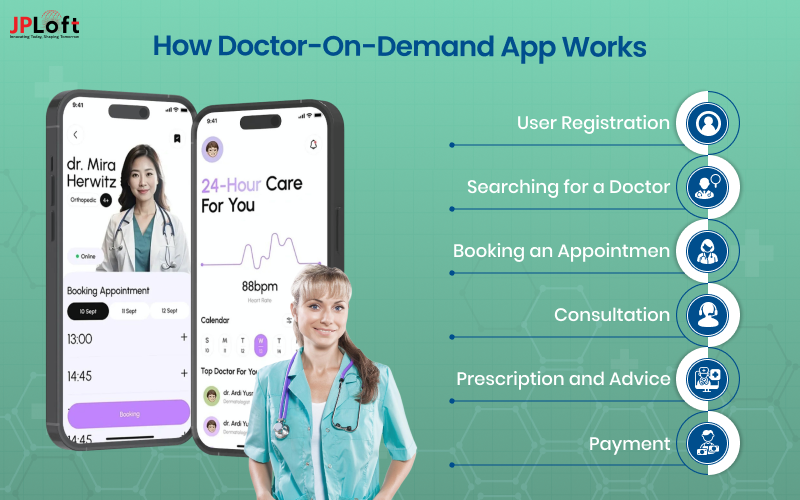
-
User Registration: Patients create an account on the app by providing basic details such as their name, contact information, and medical history.
-
Searching for a Doctor: Patients can search for doctors based on their specialties, location, availability, or specific needs.
-
Booking an Appointment: After selecting a doctor, users schedule an appointment by choosing a suitable time and mode of consultation (video, chat, or phone call).
-
Consultation: At the scheduled time, patients have a virtual consultation with the doctor through the app. They can discuss their symptoms and medical concerns.
-
Prescription and Advice: After the consultation, the doctor may provide prescriptions, recommendations, or medical advice through the app.
-
Payment: Payments for the consultation are securely processed within the app using integrated payment methods.
This smooth and virtual process makes healthcare more accessible and convenient for patients. Also, it saves time and effort for both parties.
Step-by-Step Guide to Create a Doctor-On-Demand App
Nowadays, doctor-on-demand apps have become an important and accessible service for many customers. So, you can grow your business reach by developing a courier delivery app. Here is a step-by-step guide to doctor-on-demand app development.
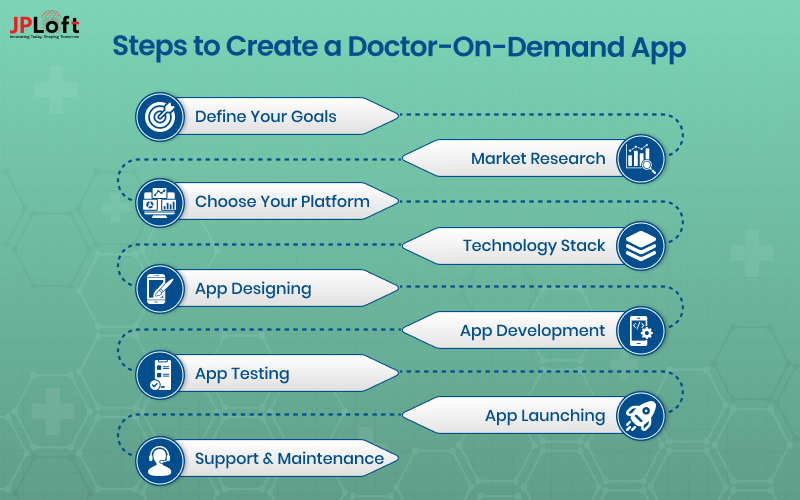
Step 1: Define Your Goals and Features
When you want to create a doctor-on-demand app, defining your goals and features is one of the most important parts. No matter whether you are focusing on general consultations or specialised care.
Understanding your app's objectives will help you determine the features you need for the app. Some common features in Doctor-On-Demand apps include:
-
Video consultations: It allows users to have face-to-face appointments with doctors.
-
Appointment scheduling: It permits users to book consultations at convenient times.
-
In-app payment system: This feature encourages users for easy and secure payments for consultations.
-
Doctor profiles: It provides detailed information about each doctor, including specialization and availability.
Step 2: Market Research and Analysis
Market research helps to identify your target audience. Target audience allows you to understand who your customers like- individuals or business persons. This step helps to study existing doctor-on-demand apps to identify their strengths and weaknesses.
It helps you research the regulations related to doctor-on-demand apps and processes. An on-demand app development company can assist you with market research.
Step 3: Choose Your Platform (iOS or Android)
When creating a Doctor-On-Demand app, deciding whether to develop it for iOS, Android, or both is essential. Since mobile app development for both platforms requires different technologies, it's essential to choose wisely.
If you want to reach a broad audience, you should develop an app for both platforms. To ensure the process, you can hire app developers to complete your app development journey.
Step 4: Choose a Technology Stack
You should choose the right technology stack for your doctor-on-demand app is one of the most important decisions for your app development. The technology stack refers to the programming languages, frameworks, and tools that will be used to build your app. Some common options include:
-
Frontend (User Interface): For Android, Java or Kotlin can be used. For iOS, Swift or Objective-C would be ideal.
-
Backend (server-side): Node.js, Python, or Ruby on Rails are popular choices for app backends.
-
Database: MongoDB, MySQL, or PostgreSQL can be used to store user data, appointment history, and medical records.
-
Cloud services: AWS, Google Cloud, or Microsoft Azure are essential for storing large amounts of data securely, especially for medical records.
Most of the app development companies offer such technology stacks through their Android app development services and iOS app development services.
Step 5: Design the App: User Experience (UX) Matters
A Doctor-On-Demand app's design should be intuitive and user-friendly. This will make the app more accessible and simple. Both patients and doctors will find it easy to navigate through the app, whether it's booking appointments, joining video calls, or reviewing medical history.
It is a necessary part to invest your time in UX/UI design. You can create wireframes and prototypes to visualize the app's flow before actual development starts. Working closely with designers ensures that the app’s interface is straightforward and user-friendly.
Step 6: Develop the App
Once the planning and designing stages are complete, the actual development of the app begins. You can either hire app developers in-house or outsource the development process to an experienced development company.
The development phase typically involves:
-
Frontend development: Creating the user interface (UI) and ensuring that the app works seamlessly.
-
Backend development: Setting up the server-side architecture to manage users, appointments, and other critical data.
-
API Integration: For video consultations, integration with APIs like Zoom or Twilio is essential.
Step 7: Test the App
App testing is a crucial step to ensure your app works properly before launching. You should conduct multiple tests to verify that. Such as-
-
The app works smoothly across all devices and platforms.
-
Video calls and communication features are stable.
-
Payment integrations are secure.
-
Users can easily book and manage appointments.
You can execute beta testing by releasing a trial version of the app to a limited audience and collecting feedback. This will help you identify issues before the official launch.
Step 8: Launch the App
Once the app is developed and tested, the launching process starts. You can include your doctor-on-demand app on popular platforms like the Apple App Store or Google Play Store.
You should ensure the specific guidelines for each platform to be approved for launch. You’ll require a strong marketing strategy to spread awareness about your app. Some of them are:
-
Social media marketing: You can use many social media platforms like Facebook, Instagram, and Twitter to reach your target audience and for marketing.
-
Paid advertisements: You can invest in Google Ads or Facebook Ads to drive traffic.
-
Influencer marketing: Partnering with influencers can be another marketing strategy. You can connect with health influencers to promote your app.
Step 9: Ongoing Support and Updates
After launching the doctor-on-demand app, you must continuously monitor its performance and ensure a smooth app maintenance process. It can address issues and provide regular updates. A Doctor-On-Demand app should be regularly updated to fix bugs, add new features, and keep up with the latest healthcare trends.
Hiring a reliable app development company can provide ongoing support and maintenance for your app. It ensures the proper functionality of the app.
This is the entire guide to doctor-on-demand app development. By following the guide, you can create a doctor-on-demand app for the convenience of the required customers.
Best Doctor-On-Demand Apps for Inspirations
Doctor-on-demand apps are a prime example of this technology transformation. This offers patients the ability to consult with healthcare professionals remotely.
If you want to make a doctor-on-demand app, you should get knowledge about the best doctor-on-demand apps. Below are the top 10 doctor-on-demand apps with their features.
|
Name of the Apps |
Features |
Downloads |
|
Teladoc Health |
24/7 access to healthcare professionals, virtual consultations for various health issues and mental healthcare services. |
50L+ |
|
Amwell |
This app is specialised in paediatrics, psychiatry, and dermatology. |
10L+ |
|
MDLive |
MDLive app provides quick and easy access to medical help. Also, allows prescription refills and a management system. |
10L+ |
|
Doctor on Demand |
This app allows video consultations with healthcare providers and accepts most major insurance plans. |
10L+ |
|
Lemonaid Health |
Affordable service fees and transparent pricing with a simple and intuitive app design. |
10K+ |
|
HealthTap |
This app provides personal health record management, health advice, and follow-up services. |
10L+ |
|
PlushCare |
Insurance coverage through major providers and allows quick access to doctors and follow-up care. |
1L+ |
|
9amHealth |
The app provides virtual doctor consultations and lab test bookings. |
500+ |
|
Better Health |
24/7 access to healthcare professionals, allowing users to consult with doctors anytime for a wide range of medical concerns. |
10K+ |
|
Avera Health Plan |
The app enables healthcare providers to conduct remote consultations with patients while ensuring privacy and confidentiality. |
1K+ |
As the healthcare landscape continues to evolve, these services are expected to grow, making healthcare even more accessible for people worldwide.
Why You Should Develop A Doctor-On-Demand App in 2025?
Nowadays, one of the most impactful changes is the rise of doctor-on-demand apps, which revolutionised how people access healthcare. Let's discuss some of the reasons why you should develop a doctor-on-demand app.

► Increased Demand for Convenient Healthcare
People today prefer convenience in all aspects of their lives, and healthcare is no exception. A doctor-on-demand app allows patients to access medical professionals from the comfort of their homes.
Whether it's for a quick consultation or a follow-up visit, the ability to see a doctor instantly via video, voice, or text, by understanding how to develop a doctor-on-demand app, you can cater to this growing demand and provide a service that offers convenience, saving patients time and effort.
► Growing Trend of Telemedicine
Telemedicine is on the rise, and it's no surprise why. More people are seeking virtual consultations as technology becomes more advanced and they increasingly trust online health services.
By building a doctor-on-demand app, you are tapping into a booming market of virtual care. As telemedicine continues to grow in popularity, having an app that provides such services will allow you to stay ahead of the competition and be a part of the future of healthcare.
► Enhanced Patient Experience
One of the most important features that make doctor-on-demand apps so attractive is the seamless user experience. Patients no longer have to wait in long lines or take time off work to see a doctor.
A simple booking system, real-time doctor availability, and an easy-to-use interface make it possible for patients to get the care they need quickly.
► Improved Healthcare Efficiency
A doctor-on-demand app benefits not only the patients but also the providers. Doctors will be able to manage their schedules more flexibly, serve a larger number of patients, and avoid the conventional barriers that come along with traditional healthcare systems.
Suppose you’re looking at how to build a doctor-on-demand app. In that case, you should integrate features that make the doctor's workflow more efficient, such as easy patient management, secure data storage, and real-time communication.
Let's discuss it.
Core Doctor-On-Demand App Features
Doctor-on-demand apps are transforming the healthcare experience by providing quick access to medical advice. If you are planning to create a doctor-on-demand app, you should know the features to develop the app that would ensure the smooth run of the app.
|
Feature Name |
Description |
User Profiles |
Allows patients and doctors to create personalized profiles with essential details like contact info, medical history, qualifications, and specialities. |
Instant Consultation Booking |
Enables users to schedule a consultation in real-time based on doctor availability, making healthcare accessible instantly without long waiting periods. |
Video & Voice Calls |
Facilitates remote consultations through secure video or voice calls, allowing doctors to assess symptoms and provide advice without an in-person visit. |
Prescription Delivery |
After consultation, doctors can send prescriptions digitally, and users can opt for home delivery of medicines, enhancing convenience. |
Appointment Reminders |
Sends automatic reminders to users about upcoming appointments via push notifications, ensuring they don’t miss their scheduled consultations. |
Medical Records Access |
Users can securely store and access their medical history, prescriptions, and past consultations for reference, enabling better continuity of care. |
Symptom Checker |
An interactive tool where users can input their symptoms to receive initial diagnoses or guidance on whether they need a consultation. |
Doctor Search & Filters |
Allows patients to search for doctors based on various filters such as specialization, location, availability, and ratings, making it easier to find the right match. |
Payment Integration |
Provides secure payment options for consultations, prescriptions, and services, integrating popular payment gateways for a smooth transaction process. |
Ratings & Reviews |
Users can leave ratings and feedback after consultations, helping others to make informed decisions and allowing doctors to improve their services. |
These features ensure that patients can easily connect with doctors, access their medical history, and receive timely care, all from the comfort of their homes.
Cost to Develop a Doctor-On-Demand App
The cost of developing a doctor-on-demand app depends on several factors that determine the final cost. The key development aspects are the platform you are targeting (iOS, Android, or both), feature complexity, design, third-party service integration, and backend setup.
The location of the development team and their skill also determine the ultimate cost. For instance, if your app requires high-end features such as video consultation, real-time notifications, and sophisticated user management systems, the cost of development will be higher.
Below is a breakdown of the different development parts and their approximate cost range:
|
Cost-Affecting Factors |
Estimated Cost |
|
App Design (UI/UX) |
$3,000 - $10,000 |
|
App Development (iOS/Android) |
$10,000 - $50,000 |
|
Backend Development |
$5,000 - $20,000 |
|
Integration of Advanced Features |
$8,000 - $30,000 |
|
Testing & Quality Assurance |
$2,000 - $7,000 |
|
Maintenance & Updates (Yearly) |
$5,000 - $15,000 |
These ranges are estimates and can vary depending on the complexity of the app and the development team's location. Also, every development process comes with its own challenges. Let's discuss the challenges that you should know before developing a doctor-on-demand app.
Key Challenges to Create a Doctor-On-Demand App
Creating a doctor-on-demand app comes with some difficulties that must be well-planned and executed. Some of them are:
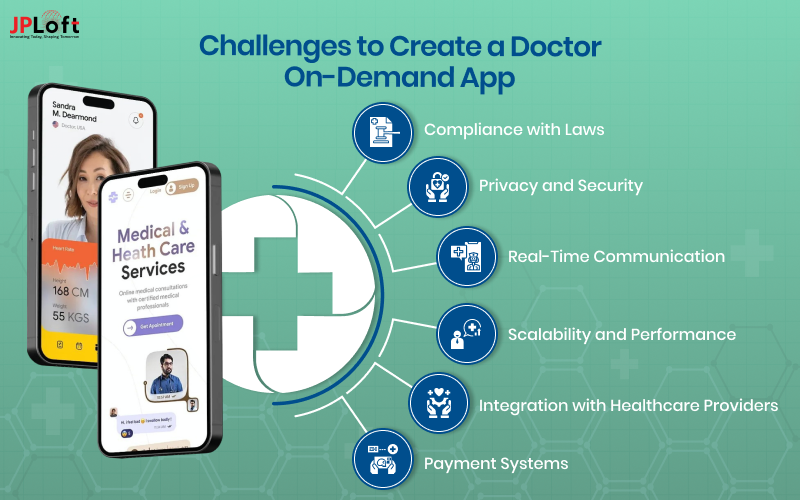
-
Compliance with Laws: Compliance with health-oriented laws (e.g., HIPAA) so that patient-related sensitive information remains protected is one of the key challenges.
-
Privacy and Security: Another challenge is ensuring the secure storage and transmission of sensitive health records to prevent any potential data breaches.
-
Real-Time Communication: Including smooth video consultation functionality and live chat capabilities without imposing much latency and maintaining quality interactions can be technologically demanding.
-
Scalability and Performance: Creating an app that manages numerous users in real-time necessitates strong backend architecture to deliver flawless performance.
-
Integration with Healthcare Providers: Forming partnerships with authorized physicians and incorporating their calendars and availability within the app may be time-intensive.
-
Payment Systems: Having secure and efficient payment gateways for services and consultations is a major challenge to providing a seamless user experience.
These challenges demand professional planning, a talented development team, and regular updates for long-term success.
Monetization Methods of Doctor-On-Demand App
Doctor-on-demand apps are growing rapidly by offering easy access to medical consultations from anywhere. As every business demands revenue at the end, these apps have several monetization methods to make it profitable.
Let's look at the most common methods.
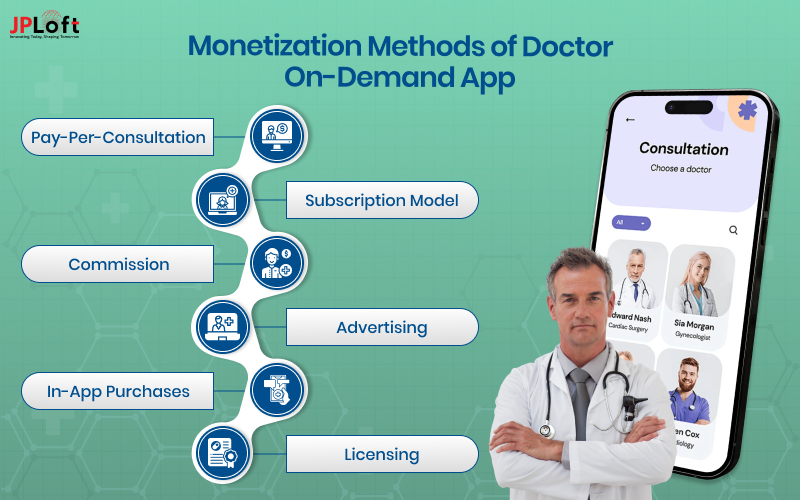
-
Pay-Per-Consultation: Users must pay a fee for each consultation they book. This will make it easy to generate revenue from individual interactions.
-
Subscription Model: Users pay a recurring fee for unlimited or discounted consultations over a set period. This can provide you with a predictable income stream.
-
Commission from Healthcare Providers: The app charges healthcare professionals a commission for each consultation they provide through the platform.
-
Advertising: You can sell ad space within the app or partner with healthcare brands to display their ads, earning revenue passively.
-
In-App Purchases: Offer additional services or health-related products for purchase within the app, such as specialised consultations or wellness plans.
-
Licensing: License your app's technology to other healthcare providers, earning revenue from its use in their practice.
Create a Seamless Doctor-On-Demand App with JPLoft
It's time to accelerate your business with your own doctor-on-demand app. In this process, JPLoft is here as a trusted and experienced doctor-on-demand app development company to help you out. With our expertise and dedication, we ensure that users can easily connect with healthcare professionals anytime, anywhere.
We focus on creating intuitive, user-friendly platforms that will help both patients and healthcare providers. Whether it’s video consultations, appointment scheduling, or secure payment integration, we take care of every detail to ensure a smooth and reliable experience.
You can build an app that not only meets the highest standards of technology but also delivers exceptional value to your users. Let us help you revolutionize healthcare with a seamless and efficient doctor-on-demand solution. Contact us today to get started.
Final Wrap Up
Developing a doctor-on-demand app is an exciting opportunity to provide accessible healthcare solutions to people everywhere. By following the guide, you can create a platform that connects patients with healthcare professionals seamlessly.
From choosing the right features to selecting the appropriate development team, every decision plays a crucial role in the success of your app. With the right approach, your Doctor-on-Demand app can make a real difference in the healthcare industry.
FAQs
A Doctor-On-Demand app allows patients to connect with healthcare professionals remotely for consultations via video, voice, or text. These apps provide a convenient and accessible way for users to receive medical care without visiting a clinic.
The key features typically include video consultations, appointment booking, payment integration, user profiles, doctor availability, prescription management, medical records storage, and push notifications
The cost can vary widely based on factors like the app platform (iOS, Android, or cross-platform), features, design, security requirements, and the development team's expertise. On average, the development cost can range from $25,000 to $1,20,000.
You can choose to develop the app for a single platform (iOS or Android) or opt for cross-platform development using frameworks like React Native or Flutter to reach both platforms at once. Cross-platform development might save costs and time but can involve some trade-offs in performance.
Depending on the complexity of the features, the development process can take anywhere from 3 to 9 months. A simple app with basic features may take less time, while a more complex app with integrations and advanced functionalities can take longer.





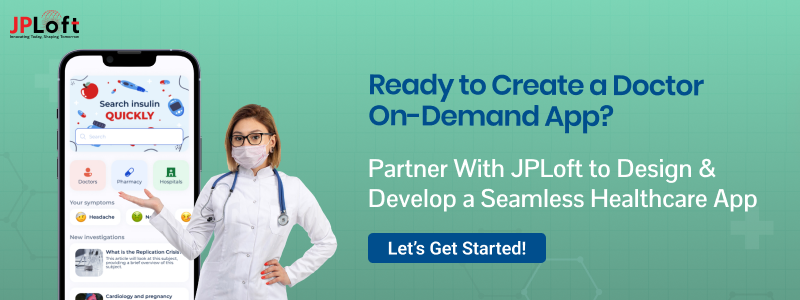
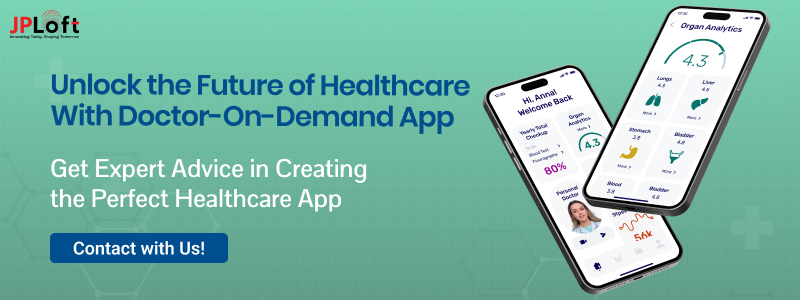



Share this blog